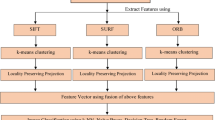Abstract
In this chapter, the performance of eXtreme Gradient Boosting Classifier (XGBClassifier) is compared with other classifiers for 2D object recognition. A fusion of several feature detector and descriptors (SIFT, SURF, ORB, and Shi Tomasi corner detector algorithm) is taken into consideration to achieve the better object recognition results. Various classifiers are experimented with these feature descriptors separately and various combinations of these feature descriptors. The authors have presented the experimental results of public datasets, namely Caltech-101 which is a very challenging image dataset. Various performance measures, i.e., accuracy, precision, recall, F1-score, false positive rate, area under curve, and root mean square error, are evaluated on this multiclass Caltech-101 dataset. A comparison among four modern well-known classifiers, namely Gaussian Naïve Bayes, decision tree, random forest, and XGBClassifier, is made in terms of performance evaluation measures. The chapter demonstrates that XGBClassifier outperforms rather than other classifiers as it achieves high accuracy (88.36%), precision (88.24%), recall (88.36%), F1-score (87.94%), and area under curve (94.07%) when experimented with the fusion of various feature detectors and descriptors (SIFT, SURF, ORB, and Shi Tomasi corner detector).
Access this chapter
Tax calculation will be finalised at checkout
Purchases are for personal use only
Similar content being viewed by others
References
Lowe DG (2004) Distinctive image features from scale-invariant keypoints. Int J Comput Vision 60(2):91–110
Bay H, Tuytelaars T, Van-Gool, L (2006) Surf: speeded up robust features. In: Proceedings of the European conference on computer vision, pp 404–417
Rublee E, Rabaud V, Konolige K, Bradski GR (2011) ORB: an efficient alternative to SIFT or SURF. In: International conference computer vision, vol 11, no 1, p 2
Shi J, Tomasi (1994) Good features to track. In: Proceedings of IEEE conference on computer vision and pattern recognition, pp 593–600
Chen T, Guestrin C (2016) XGBoost: a scalable tree boosting system. In: Proceedings of the 22nd ACM SIGKDD international conference on knowledge discovery and data mining, pp 785–794
Quinlan JR (1986) Induction of Decision Trees. Mach Learn 1(1):81–106
Kleinberg EM (1996) An overtraining-resistant stochastic modeling method for pattern recognition. Ann Stat 24(6):2319–2349
Fei-Fei L, Fergus R, Perona P (2004) Learning generative visual models from few training examples: an incremental Bayesian approach tested on 101 object categories. In: Proceedings of the conference on computer vision and pattern recognition workshop, pp 178–178
Ren X, Guo H, Li S, Wang S, Li J (2017) A novel image classification method with CNN-XGBoost model. Lecture Notes in Computer Science, pp 378–390
Santhanam, R., Uzir, N., Raman, S. and Banerjee, S. (2017) Experimenting XGBoost algorithm for prediction and classification of different datasets. In: Proceedings of the national conference on recent innovations in software engineering and computer technologies (NCRISECT), Chennai
Bansal A, Kaur S (2018) Extreme gradient boosting based tuning for classification in intrusion detection systems. In: Proceedings of the international conference on advances in computing and data sciences, pp 372–380
Vo T, Nguyen T, Le CT, A hybrid framework for smile detection in class imbalance scenarios. Neur Comput Appl, 1–10
Harris C, Stephens M (1988) A combined corner and edge detector. In: Proceedings of the fourth Alvey vision conference, pp 147–151
Song R, Chen S, Deng B, Li L (2016) eXtreme gradient boosting for identifying individual users across different digital devices. Lecture Notes in Computer Science, pp 43–54
Asch VV (2013) Macro-and micro-averaged evaluation measures. CLiPS, Belgium, pp 1–27
Brodersen KH, Ong CS, Stephan KE, Buhmann JM (2010) The balanced accuracy and its posterior distribution. In: Proceedings of the 20th international conference on pattern recognition, pp 3121–3124
Godbole S, Sarawagi S (2004) Discriminative methods for multi-labeled classification. In: Proceedings of the Pacific-Asia conference on knowledge discovery and data mining, pp 22–30
Author information
Authors and Affiliations
Corresponding author
Editor information
Editors and Affiliations
Rights and permissions
Copyright information
© 2021 Springer Nature Singapore Pte Ltd.
About this paper
Cite this paper
Monika, Kumar, M., Kumar, M. (2021). XGBoost: 2D-Object Recognition Using Shape Descriptors and Extreme Gradient Boosting Classifier. In: Singh, V., Asari, V., Kumar, S., Patel, R. (eds) Computational Methods and Data Engineering. Advances in Intelligent Systems and Computing, vol 1227. Springer, Singapore. https://doi.org/10.1007/978-981-15-6876-3_16
Download citation
DOI: https://doi.org/10.1007/978-981-15-6876-3_16
Published:
Publisher Name: Springer, Singapore
Print ISBN: 978-981-15-6875-6
Online ISBN: 978-981-15-6876-3
eBook Packages: Intelligent Technologies and RoboticsIntelligent Technologies and Robotics (R0)




